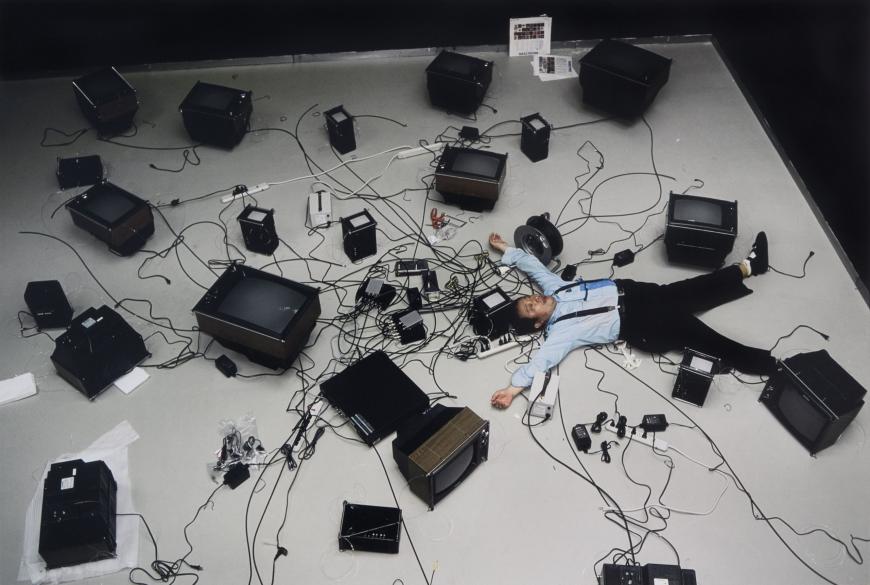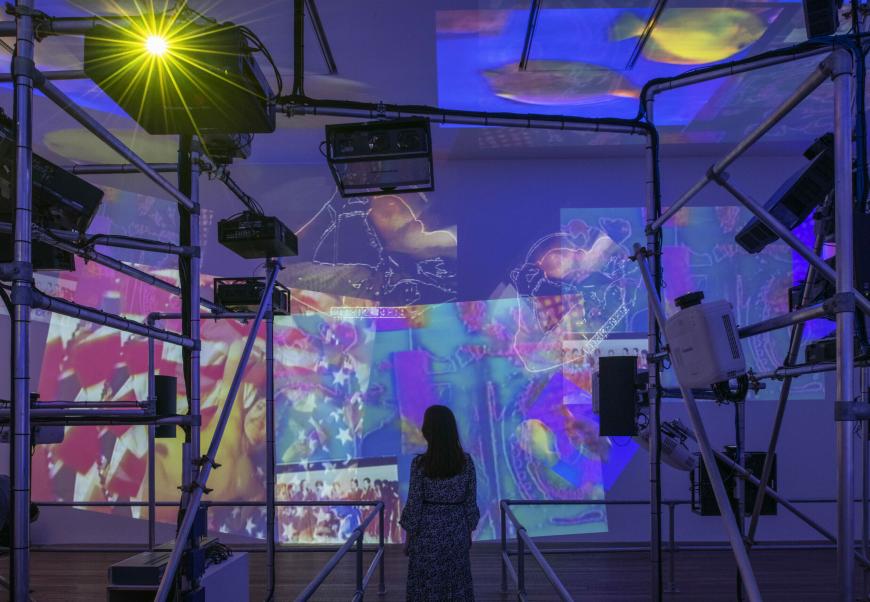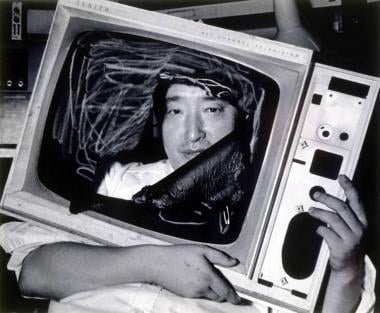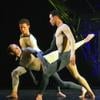
Nam June Paik, born in Seoul in 1932 during the Japanese occupation of Korea, had a five-decade career that included large-scale video installations, global satellite projects, and a fascination with TV sets, which he used to make all kinds of things, including a pair of glasses, a bra, and a cello out of three chunky TVs stacked on top of one another.
The first West Coast retrospective of Paik’s work at the San Francisco Museum of Modern Art, through Oct. 3, encompasses his entire career and includes more than 200 of his works. Known as the father of video art, Paik’s musical background — he trained as a classical pianist, studied music at the University of Tokyo where he wrote his thesis on composer Arnold Schoenberg, and then went to study music history at Munich University — was important to everything he did, says Rudolf Frieling, the curator of the show.
When covering an artist’s career in a retrospective, Frieling says he likes to add something new, and in this show that comes with the closing moment: a restaging of Paik’s Sistine Chapel from the 1993 Venice Biennale, where it won the Golden Lion award. Sound and images are projected onto the walls and ceiling including tropical fish, David Bowie, Alvin Ailey dancers, Lou Reed playing his guitar, and many of Paik’s collaborators.

Frieling also wanted to highlight an aspect of Paik’s career that hadn’t gotten as much attention as he thinks it deserves — Paik’s background in music.
“He started with the idea of classical music — and how to get away from it,” Frieling said. “But also, music has literally, in my perspective, influenced every step of his way.”
The show begins with 1961’s unrealized Symphony for Twenty Rooms, which is like a blueprint for Paik’s career, Frieling says.
“The more you look at it, the more you realize, specifically after having seen the show, that you’ve come across parts of this,” Frieling said. “Oh, yes, audience participation is clearly something I’ve seen, a live element is something I’ve seen, and the radical mix of so many different sources is clearly in his work.”
Other works in the show include Paik’s Magnet TV, where a magnet twists a TV’s electronic signals into a changing pattern; TV Buddha where an 18th-century wooden Buddha appears to watch itself on a modern television; and TV Garden, one of Paik’s most famous works, with 49 TVs in the midst of live plants, cycling through blasting out Paik’s music video “Global Groove” (1973), a mix which includes performances by John Cage, Merce Cunningham, and Allen Ginsberg; a Japanese Pepsi commercial; Mitch Ryder’s “Devil with a Blue Dress On”; and traditional Korean dancers. It showcases what Paik is known for — combining traditional and contemporary sources across cultures.

Assistant curator Andrea Nitsche-Krupp says Paik did this in things like pairing Taiko drumming with the Charleston.
“He’s not making a judgment,” she said. “There’s some value to be found in all of these examples of music in other cultures.”
The show also includes Video Commune, which the museum has put online, and which was broadcast live on TV in 1970, where viewers were invited to watch a four-hour silent video and create their own soundtrack of Beatles music.
“They put out a call to just play your record, and any record you want to play will go well with the visuals we provide,” Frieling said. “There’s this idea that you could relate to television as something that’s interactive.”
Paik was known for long collaborations with artists, and one who most profoundly influenced his work was John Cage, who he met at the end of the 1950s while he was studying in Germany. Paik, who said listening to Cage was like chewing sand, called him a great composer who had taken the seriousness out of serious music, the way he, Paik, aimed to take the seriousness out of TV. After meeting Cage in 1958, Paik started using objects and prerecorded sounds in his compositions, which he called “action music.” In 1960, in his Étude for Piano Forte, those actions included jumping off the stage, cutting off Cage’s tie, and dumping shampoo on his head, leading Cage to say (understandably) that he’d think twice before attending another Paik concert.
In Germany, Paik also met George Maciunas, the founder of Fluxus, an experimental art movement with an anti-commercial aesthetic, attracting artists such as Yoko Ono. Paik joined in their performances in Europe and then in New York. Another friend and collaborator was Joseph Beuys, who took an axe to a piano at a 1963 Paik exhibition, Exposition of Music — Electronic Television, which, Frieling tells me, Paik (perhaps unsurprisingly) found a perfectly valid response.
Words often used to describe Paik and his work include “irreverent,” “groundbreaking,” “visionary,” and “playful.” Watching Paik in composer Karlheinz Stockhausen’s 1961 Originale, for example, you see his magnetism, Nitsche-Krupp says.
“The soundtrack is Stockhausen’s score, and different people had a slot to do whatever they wanted,” she said. “Paik had this segment where he did a series of actions like buttoning and unbuttoning a button or putting a hand in front of his face, and he does it with such control and sincerity, it’s hard not to be charmed.”
A gallery in the exhibition is devoted to the collaboration between Paik and Charlotte Moorman, a cello player who worked with Paik for 30 years. They wanted to bring sexuality to classical music and in Paik’s 1967 Opera Sextronique, Moorman was arrested mid-concert for performing topless (she was supposed to be nude by the end of the performance.)
In response, Paik made TV Bra for her. He also made TV Eyeglasses and TV Cello, which are all in the show along with rare footage of Moorman and Paik’s performances. Frieling thinks TV Cello in particular epitomizes a quote from Paik that’s on a gallery wall: “Is it music? Well, it is not not music.”
Composer, conductor, performance artist, and music historian Luciano Chessa, who is currently living in Berlin, agrees with Paik that sexuality and physicality are ignored in classical music, to its detriment. He says his students at the San Francisco Conservatory of Music in 2007, New York University in 2018, and now in Berlin have had pretty similar views about Fluxus when he teaches it.
“Their aesthetic reaction is pretty much the same — that this is performance art that belongs in an art school, and we don’t have to engage, and we don’t have to feel attacked,” he said. “But it is our business, and we need to get engaged with this and come to terms with it. Sending the message back to the sender is really a bad idea. Engaging with it forces you to consider music as performance, and you start to compose differently.”




